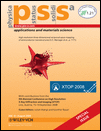Measurement of the spatial coherence of synchrotron beams using the Talbot effect
Abstract
We present an application of the Talbot effect [Talbot et al., Philos. Mag. 11, 196 (1836)] to measure the spatial coherence of a synchrotron beam, as well as the influence of optical elements on it. One advantage of using this effect is that regions of the beams down to 50 µm × 50 µm are still analysable (in our case). This spatial resolution allows analysing the local coherence degradation caused by small regions in the investigated optical element, like windows or Bragg diffraction crystals with defects. A second advantage is the independence of the results on the detector point spread function. This method is used by the Optics and the X-ray Imaging Group at the ESRF in the hard X-ray domain at 20.5 keV. Although already presented by Cloetens et al., J. Synchrotron Radiat. 11, 476 (2004), this technique was mainly used to analyse the spatial beam coherence itself. In order to measure the coherence degradation due to non-perfect optical elements, we improved the data analysis which was very deficient when applied to diffractive samples. These improvements have led to accurate and reliable results and have allowed to extend the application field of that method towards diffracting crystals.




